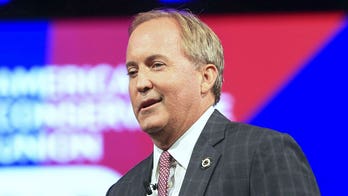Obama’s Small Debt Reduction May Be Smaller in Reality
“It looks like the debt is going to continue rising under that budget.”
-- House Budget Chairman Paul Ryan, R-Wisc., on “FOX News Sunday”
President Obama’s budget out today will call for a 10-year debt reduction plan that trims what the federal government owes by less than half of the deficit spending he projects for the current fiscal year and next year.
Obama’s plan calls for a combination of tax increases and smaller spending increases to come up with a plan to shave $1.1 trillion from the national debt by 2022. But in the same document, Obama calls for that very amount of deficit spending in the next year alone and projects more than $1.6 trillion in shortfalls for the current fiscal year.
With House Republicans unlikely to accept any of Obama’s calls for additional spending on stimulus measures next year, the president’s budget is useful only as his opening bargaining position for short-term questions and a sort of position paper on Obama’s long-term plan for the nation.
To call the plan modest is an understatement. Administration officials, looking to soften the landing of the proposal, have explained that there is so little austerity in the president’s budget that Obama did not want to foreclose any options when negotiations begin with House Republicans and Senate Democrats.
And, to be sure, this proposal certainly gives the administration lots of bargaining room when the president faces down with the deficit hawks in the House. But by coming in with such a lowball offer, the president further damages his credibility on the issue. Remember that in last week’s FOX News poll, 61 percent of registered voters didn’t believe Obama’s State of the Union rhetoric that he could spend more on his agenda and still cut the deficit.
One of the reasons that the president’s plan, floated in great detail in advance of its release, is getting such poor reviews from fiscal hawks, is that future year forecasts on federal spending carry about as much weight as your daily horoscope.
Even within one year, optimistic presidential projections combined with major events can cause forecasts to miss wildly. President George W. Bush’s last budget, built before than Panic of 2008, the election of Barack Obama and the passage of two stimulus packages, underestimated the deficit for the fiscal year that ended in September 2009 by fully $1 trillion.
And Obama’s budgets are famous for seeing the world through hope-colored glasses.
Obama’s first budget (title: “A New Era of Responsibility”) forecast a 1.2 percent reduction in gross domestic product with an 8.1 percent unemployment rate for 2009. The reality was a 2.6 percent contraction of the nation’s economy and 9.3 percent unemployment. For 2010, Obama’s plan relied on 3.2 percent growth and 7.9 percent unemployment. The current estimate of last year’s growth rate is 2.9 percent with an annual unemployment rate of 9.6 percent.
And so it goes with deficits, too. Obama called for $1.17 trillion in deficit spending for the fiscal year beginning in October 2009, but the actual cost overrun was $1.29 trillion. For the current fiscal year, the president’s plan called for $1.27 trillion in deficit spending. The plan out today will say that the final number will be more like $1.65 trillion.
The only deficit projection on which the president has been pessimistic was the one that he partly inherited. Obama forecast the government would overrun its revenues by $1.75 trillion in the year between October 2008 and the end of September 2009. The final number was $1.4 trillion.
So, before you take the “$1.1 trillion in debt reduction over the next decade” story line to heart, look closely at what Obama sees happening over that period. What are the growth estimates? What is the projected economic effect of the proposed tax increase? How does he see interest rates on new U.S. debt?
Be especially circumspect when dealing with any projections that are forecast as a percentage of GDP. If anyone knew what the economy would be doing five or ten years from now, they wouldn’t be in Washington pushing paper. They’d be in New York making billions.
Given sufficient economic wiggle room and a long enough time frame, any budget boss worth his salt can come up with a pretty rosy forecast. So, the reality on debt and deficits could be much more meager than the already modest projections out today.
The Budget Proposed Today is More Political than Practical
“And I think it's important to note that we're beyond the easy, low-hanging fruit.”
-- Office of Management and Budget Director Jack Lew on “State of the Union” previewing President Obama’s budget
President Obama wants to spend $3.7 trillion in the next fiscal year. Republicans want to spend about $2.9 trillion. Even by Washington standards, $800 billion is a pretty big gap.
To understand how formidable a challenge President Obama’s budget will face in Congress, remember that even with Democratic supermajorities in both houses of Congress, Obama’s budget stalled last year.
In fact, last year was the first time since budgetary accountability measures were imposed in 1974 that Congress didn’t pass any budget at all. The government has operated since the start of the fiscal year on Oct. 1 on a series of continuing resolutions, the current one set to expire on March 4.
But long before last year’s glaring budget breakdown, it had become commonplace in Congress to operate in a parallel universe when it came to budgets. For example, the cost of fighting the wars in Afghanistan and Iraq hasn’t been included in any budgets, but has instead been dealt with as “supplemental appropriations.” The war costs have been no surprise, but they have been funded as emergency measures for as long as they have been fought. That follows a long congressional tradition of treating planned spending as “supplemental” spending in order to dodge the budget process.
Some of the greatest appropriations abuses of the recent past have come in these “supplemental” measures, when normal budgetary rules aren’t in effect and earmarks could be easily inserted.
While President Obama today will present his budget as a soup-to-nuts plan for fiscal year 2012, it is really the start of a negotiating process with Congress. And it is a small start, indeed.
The administration’s budget suggests $33 billion in “savings” for 2012 compared to the current funding rates. That’s way at the low end of the spectrum.
The most modest Republican proposal calls for cuts that deep in the remaining seven months of this budget year. The leading Republican proposal, recently put forward in the House Appropriations Committee, is for double that. Comparable cuts for the full year in 2012 are expected to be at least triple what Obama is suggesting.
And though Democrats still control the Senate, the dominant political faction in the upper chamber these days is the budget hawks. The bipartisan push for cuts to this year and for even more serious belt tightening next year is real. Sens. Joe Lieberman, Claire McCaskill and others have gotten behind some tough fiscal stances of late.
In the previous two years, Obama got to play referee between the liberal House and more moderate Senate. Obama got to negotiate differences between the two wings of his own party and play peacemaker. The president’s position has now changed. The House moved from far left to far right and the Senate is more evenly divided.
That means that the Senate will still dictate the final terms of any budget agreement, thanks to the body’s 60-vote threshold, but Obama is now the most liberal player in the three-way game – moderate Senate, conservative House, liberal president.
While Obama may want to demonstrate his own moderate credentials in the run-up to 2012, he is the only one to advance the kind of spending needed to promote the president’s agenda.
By entering his opening bid on spending so high, Obama is hoping to produce a final result that preserves some of his agenda. Yes, the administration knows that money for high-speed trains and solar panels will likely get shaved off, but as in any negotiation, the administration has come to the table with some padding built in.
Remember also the negotiations over next year’s budget will come only after the more pressing battles on spending are fought.
First, Congress has to address the soon-to-expire continuing resolution. That’s going to take awhile. The Senate is already preparing another stopgap spending proposal to get the government beyond March 4. House Republicans and the president are currently $100 billion apart for the rest of the year. We’ve yet to hear any substantive proposal from the Senate.
Meanwhile, the administration’s request for an increase in the $14.3 federal debt limit is also looming. The government will run out of credit sometime before early May and the president is demanding an answer next month so as to assure jittery bond markets.
Congress doesn’t have to decide on a budget for many months, and, as the previous Congress showed, could opt to simply abrogate its responsibility in that front. The outcome of fights over current spending and the debt ceiling will have a lot more to say about the shape and size of the 2012 budget than the president’s proposal today.
White House Argues That Not Addressing Long-Term Problems Will Help Resolve Long Term Problems
"…nowhere near where they will have to go to resolve our fiscal nightmare."
-- Erskine Bowles, Democratic co-chairman of President Obama’s debt commission, describing the president’s budget to the Washington Post
Mandatory spending on welfare programs like Social Security and Medicaid accounts for about 60 percent of federal outlays.
Add in the more than $100 billion a month we’re currently paying on existing U.S. debt and you quickly see that for all the talk about deficit from the White House today, the president’s budget addresses only about a third of the problem.
It is notable to all that despite crafting a decade-long projection on debt and deficits, President Obama’s Office of Management and Budget has taken a pass on the core recommendations made by the president’s own debt reduction commission.
The closest the 2012 Obama budget comes to addressing entitlement reform is forecasting massive savings to existing programs from the president’s as-yet unimplemented national health care law.
The administration defends the decision to punt on dealing with the biggest parts of spending for the next decade on the grounds that the president wanted to address those issues separately and without any political preconditions. The message is that now is not the time to talk about big things, but to focus on small, symbolic details.
The argument today is that by not addressing the larger concerns surrounding the debt and deficit, the administration is making it more likely those issues will be resolved.
If ignoring entitlement problems is the way to facilitate action, the ground should be well plowed. Washington has been ducking this issue for two decades.




